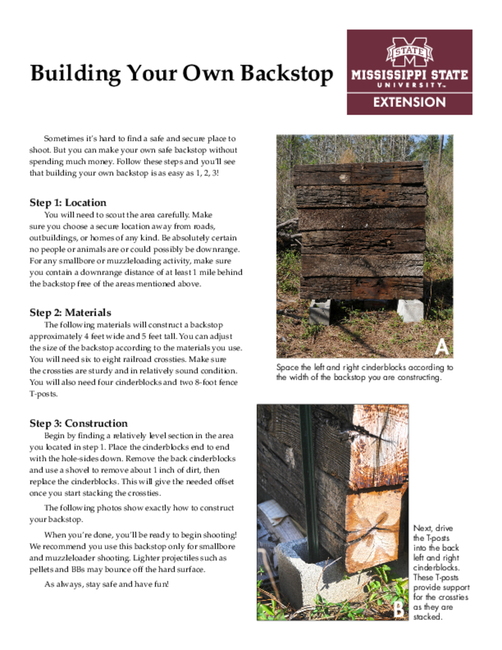Building Your Own Backstop

Sometimes it’s hard to find a safe and secure place to shoot. But you can make your own safe backstop without spending much money. Follow these steps and you’ll see that building your own backstop is as easy as 1, 2, 3!
Step 1: Location
You will need to scout the area carefully. Make sure you choose a secure location away from roads, outbuildings, or homes of any kind. Be absolutely certain no people or animals are or could possibly be downrange. For any smallbore or muzzleloading activity, make sure you contain a downrange distance of at least 1 mile behind the backstop free of the areas mentioned above.
Step 2: Materials
The following materials will construct a backstop approximately 4 feet wide and 5 feet tall. You can adjust the size of the backstop according to the materials you use. You will need six to eight railroad crossties. Make sure the crossties are sturdy and in relatively sound condition. You will also need four cinderblocks and two 8-foot fence T-posts.
Step 3: Construction
Begin by finding a relatively level section in the area you located in step 1. Place the cinderblocks end to end with the hole-sides down. Remove the back cinderblocks and use a shovel to remove about 1 inch of dirt, then replace the cinderblocks. This will give the needed offset once you start stacking the crossties.
The following photos show exactly how to construct your backstop.
When you’re done, you’ll be ready to begin shooting! We recommend you use this backstop only for smallbore and muzzleloader shooting. Lighter projectiles such as pellets and BBs may bounce off the hard surface.
As always, stay safe and have fun!

Space the left and right cinderblocks according to the width of the backstop you are constructing.

Next, drive the T-posts into the back left and right cinderblocks. These T-posts provide support for the crossties as they are stacked.

The T-posts should be level with the back of the top layer of crossties once the structure has been constructed. This is to prevent any ricochet from a projectile striking the metal of the T-post.

Cut the crossties in half and stack them two deep with the long side facing out. As you are stacking the crossties, make sure the seams of the back layer are offset from the front layer. This will prevent a projectile from passing through the backstop.

Once completed, the backstop should not be leaning or unstable.
Information Sheet 1920 (POD-10-20)
Distributed by Tammy Parker, Extension Agent and Interim 4-H S.A.F.E.T.Y. Program Coordinator.
